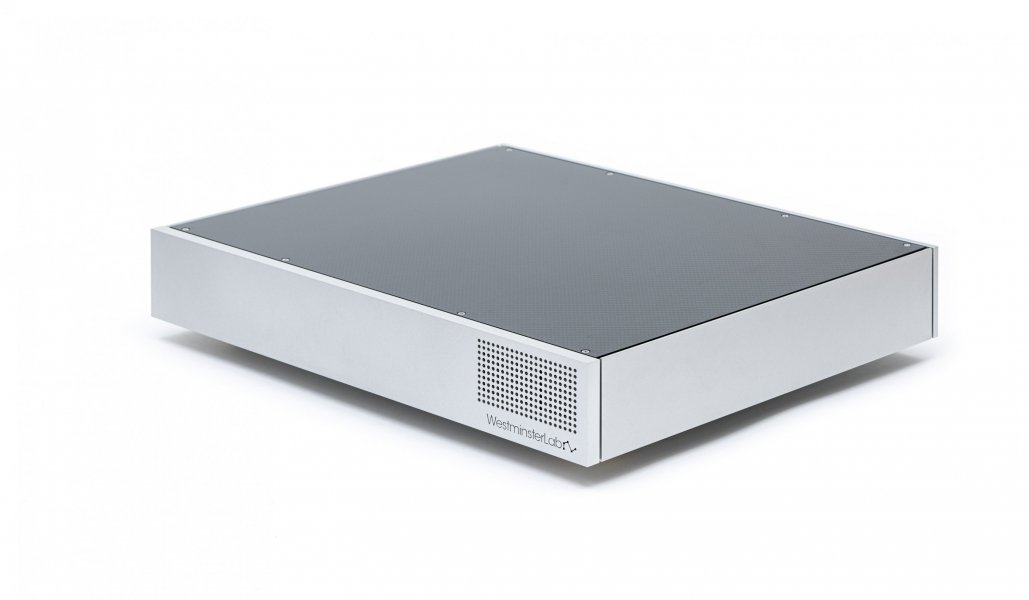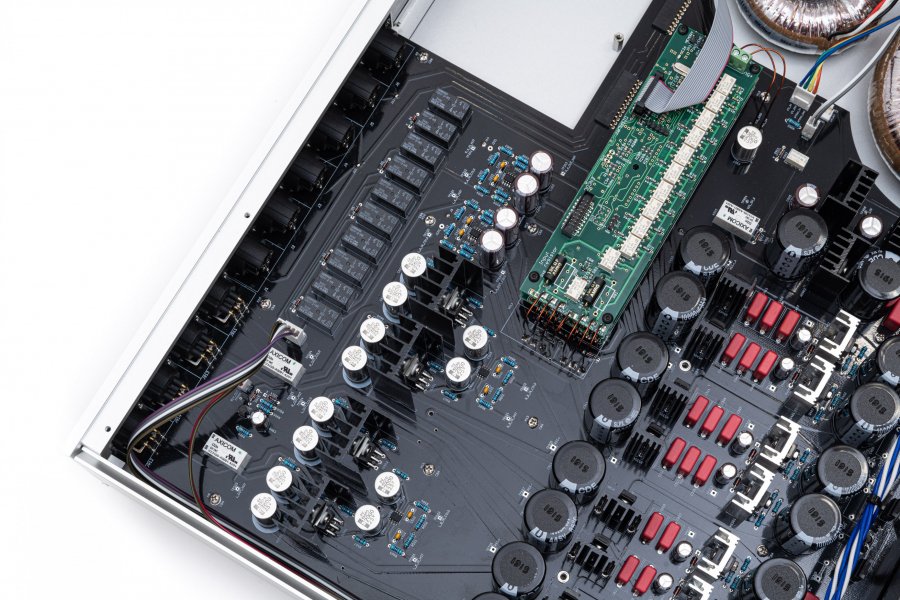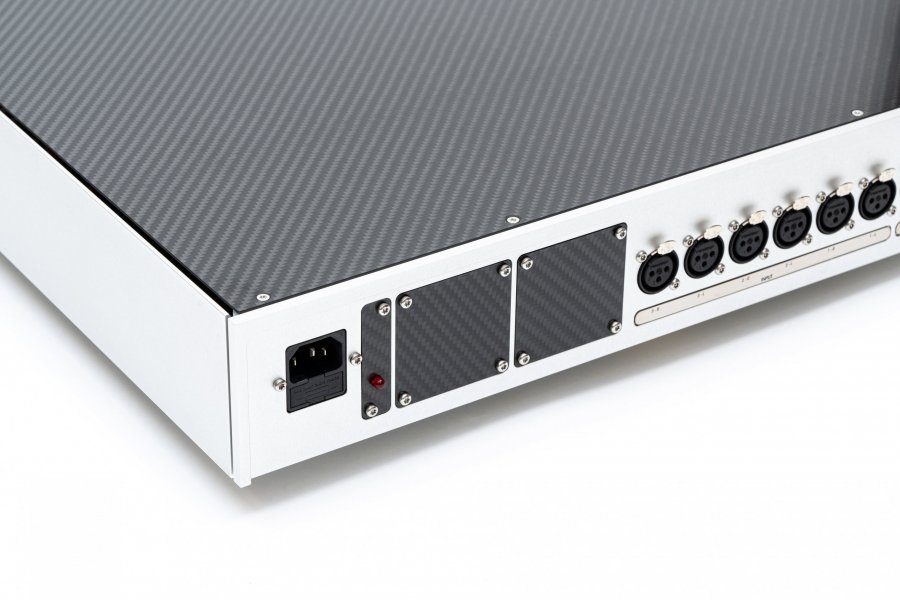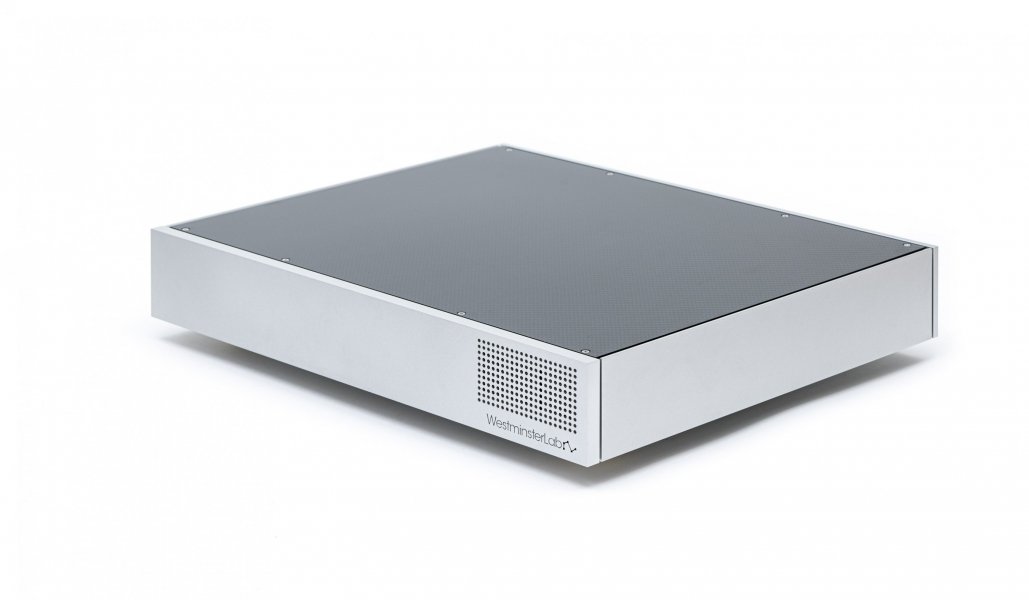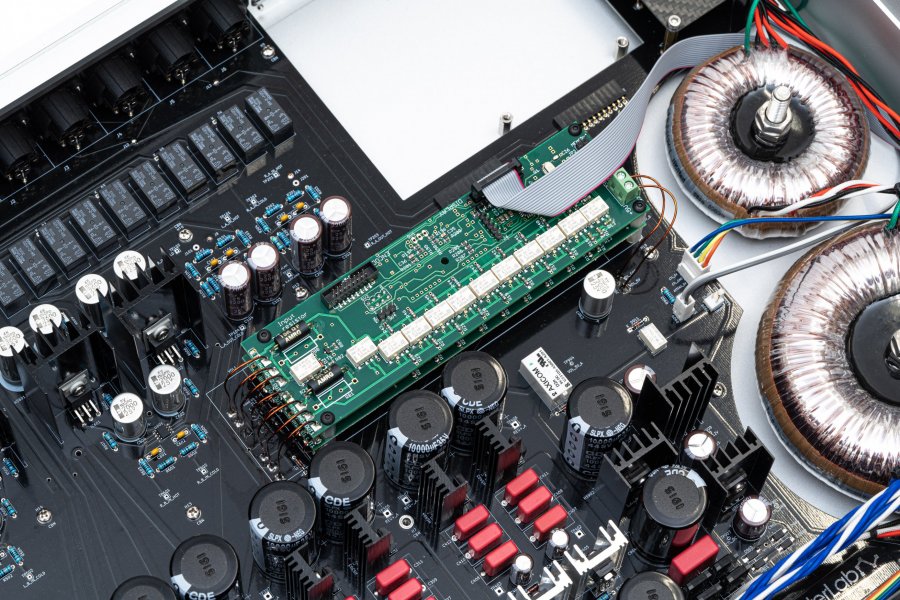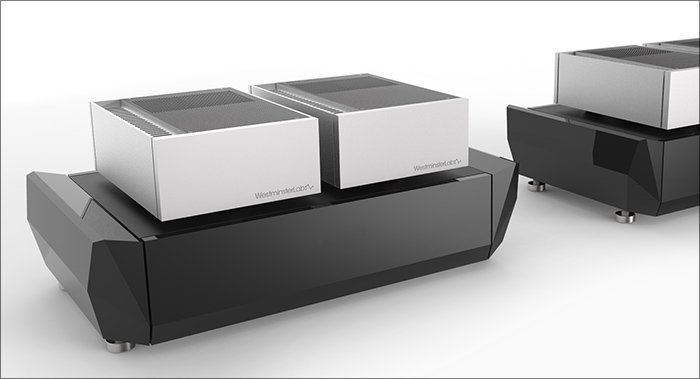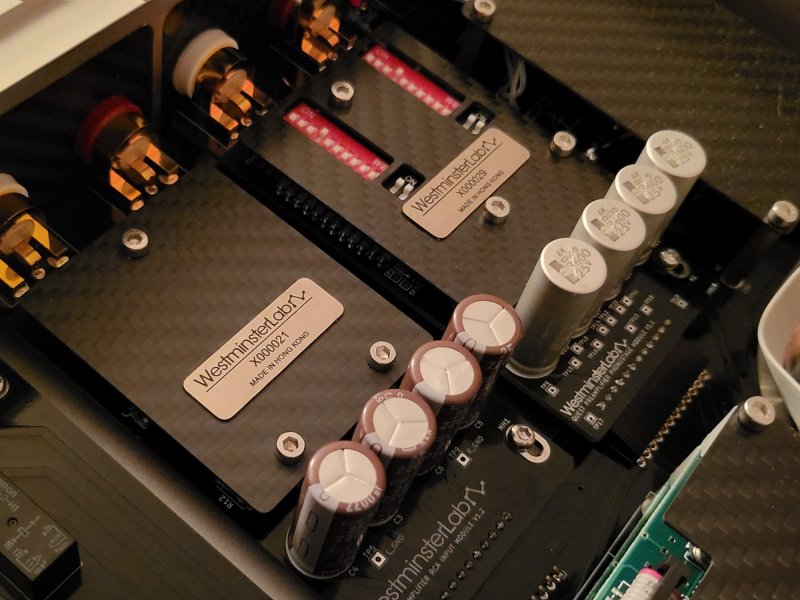Did you also try without the Pass preamp, going directly from the Horizon into the amps?GT Audio Works, speakers, Westminster Labs REI amplification, LampizatOr Horizon source and Pass Lab's big 3 box pre.... it was a lovely setup.
WestminsterLab Re-imagining Amplification
- Thread starter gleeds
- Start date
You are using an out of date browser. It may not display this or other websites correctly.
You should upgrade or use an alternative browser.
You should upgrade or use an alternative browser.
We did not--I think the sub towers were being output from preouts and they'd just finished setting them back up after the NY Show so we didn't want to mess with them. I'll be back over there again in the near future though and with the Quest pre next time too.
We may actually duplicate this setup for the upcoming Capital AudioFest show as I think it would make a huge impression.
We may actually duplicate this setup for the upcoming Capital AudioFest show as I think it would make a huge impression.
Preamplifiers in the Digital Age - are they needed?
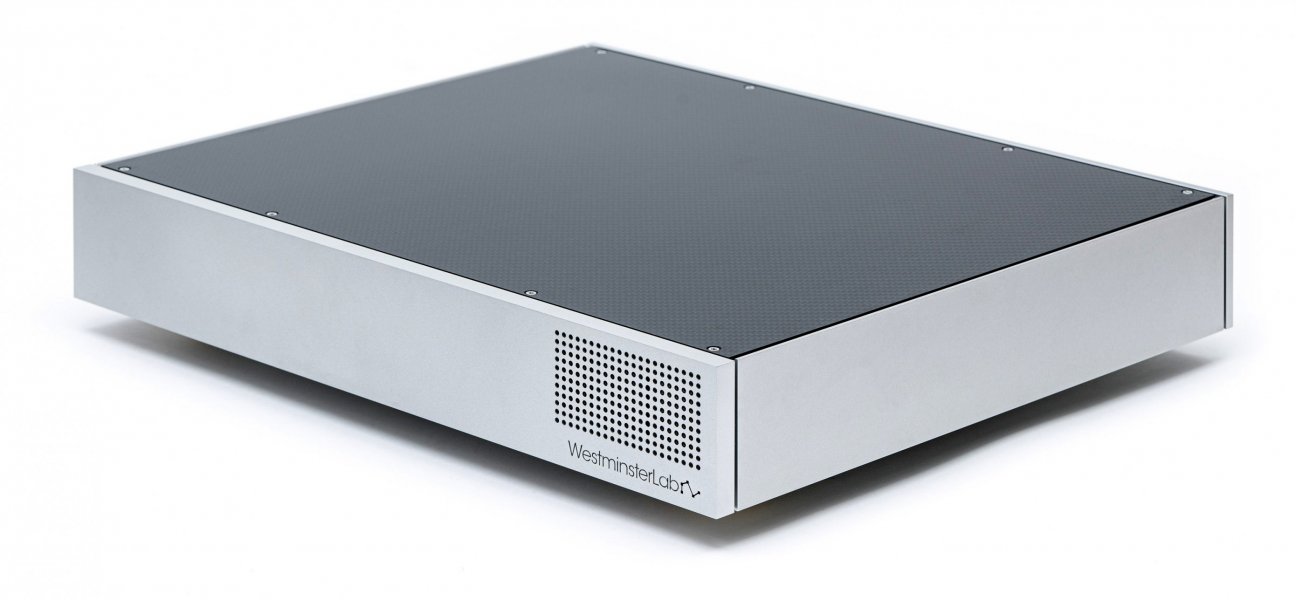
Members of WBF have discussed the importance of a system preamplifier when owning a DAC with volume control onboard. MSB. Lampizator, CH Precision, and Lumin (the ladder using Leedh signal processing ) are excellent examples of the breed. While both uses are valid, like many choices, it is also a matter of taste which sounds better.
The Quest preamplifier is an active, fully balanced dual-mono design housed in an elegant, rigid aluminum chassis. The noise floor is very low due to the extensive use of Carbon fiber inside the chassis and the use of ten separate power supplies. In designing the Quest, the goal was to create a product that would act as a flexible control center and, at the same time, make a meaningful improvement in the sound quality of your system. The Quest is also available in a two-chassis dual mono configuration for ultimate performance.
In-home demos of the Quest are available for qualified individuals.
New item: The Quest Preamplifier Precision Phono Module "PPM"
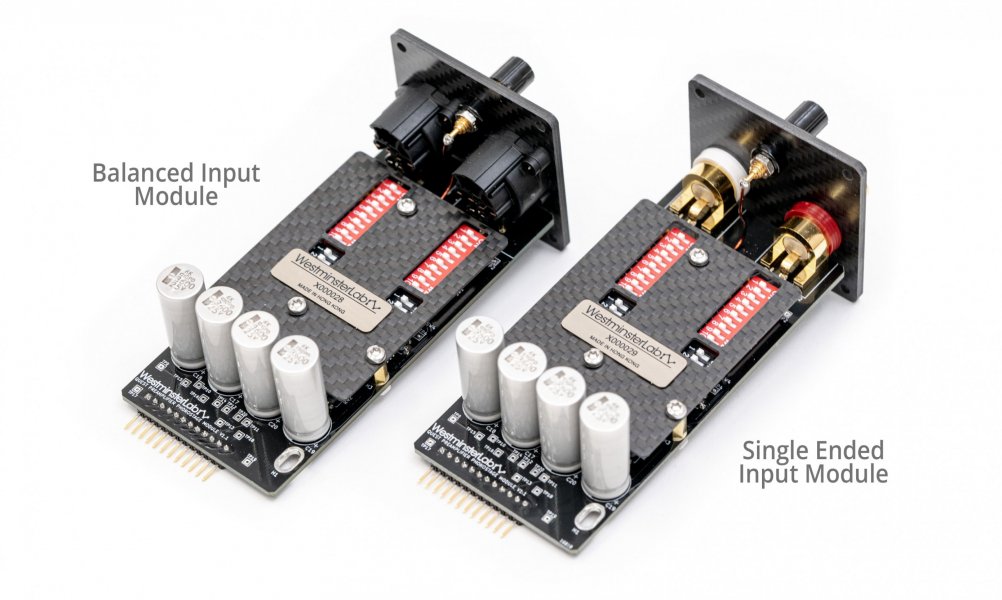
Amplifying the tiny analog signals of a cartridge without distortion is a monumental task. So with this as our challenge, we set out to create a vinyl replay module for the Quest preamplifier compatible with the finest phono cartridges and delivering our hallmark sound signature - texture, transparency, detail, and dynamics. Two versions of the PPM are available with either balanced or single-ended inputs.
Here are the specifics.
Ultra-low current noise levelsMaintaining musical information in phono amplification requires a power source. Westminster's Precision Phono Module module uses specially designed power supplies inside the Quest as the primary power source. The signal then passes through a secondary filter resulting in very low measurable voltage deviation and current-related noise.
Precision RIAA Equalization
The RIAA Equalization circuit consists of only four passive components, a number far less than most phono stages on the market. However, not willing to forgo accuracy for our "less is more" circuit topology; we have also achieved within 0.5db of the RIAA reference. The result is accuracy and the ability to deliver information retrieved by the stylus as untouched as possible.
Flexible Impedance and Capacitance matching
The appropriate impedance settings are crucial to extracting the best possible performance from your cartridge. To meet these demands, we provide eighteen different impedance selections ranging from 60Ohm to 47kohm and five for input capacitance from 22p to 322pF. There are also three gain settings from 50db to 72db.
Three-stage precision amplification
Signals picked up from the cartridge are extremely small and require large multiples of amplification. Therefore, our PPM module uses an unconventional three-stage amplification process. Each stage is optimized to prevent overload and keep distortion as low as possible while acting in concert to apply accurate RIAA EQ equalization.
Bespoke Coupling Capacitors
AC signals produced by the cartridge are microscopic. Passive components used in most phono stages do not perform well in this environment. To solve this problem, the PPM uses custom capacitors to ensure distortion and coloration are at the lowest possible level, revealing newfound ease, flow, and previously obscured information.
True to the Original
Many phono preamplifiers use filters to reduce background noise and mitigate distortion. While this can result in a perceived sound quality improvement, we believe these filters rob music of critical information and add coloration. As a purist design, the PPM phono module reveals all the information found in the record groove so you can experience vinyl as it is!
The Quest preamplifier with or without phono stage is available for in-home auditions. Please get in touch with Gary Leeds via PM or email to inquire.
The Rei "Quadrablock" Amplifiers (4-chassis power solution)
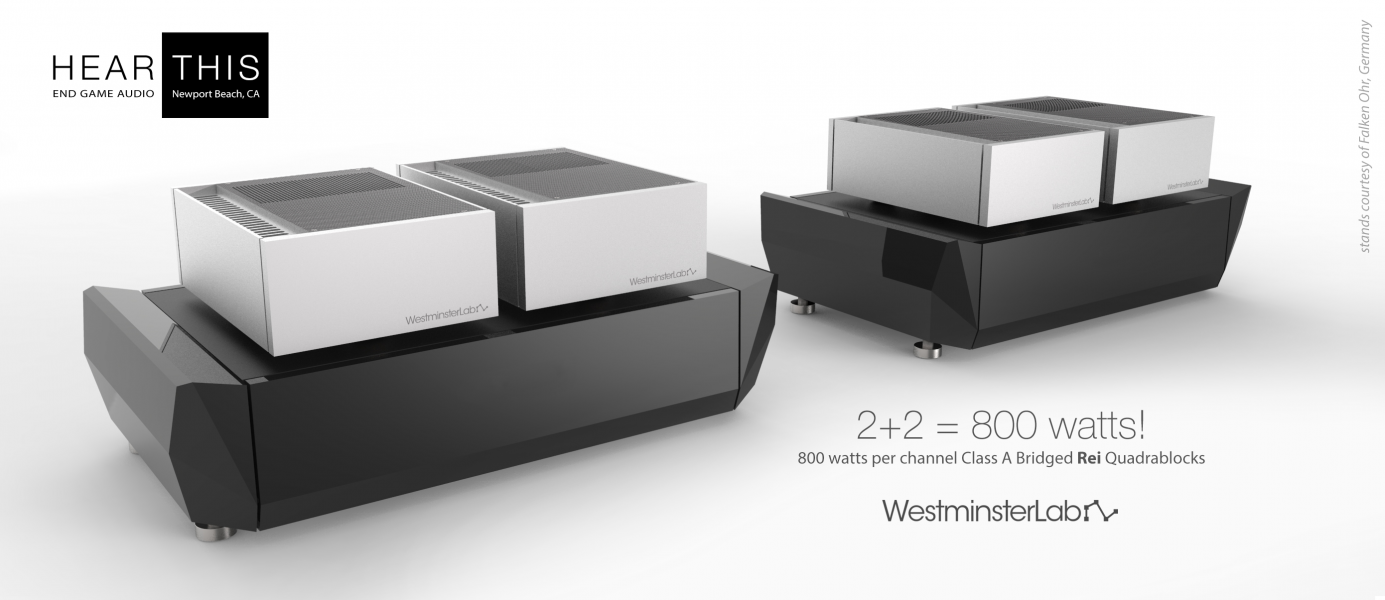
The four-Rei Class A monoblocks are available where the Rei Quadrablocks leave off. From day one, the Rei used in Quadrablock configuration was designed for maximum performance and a simple upgrade path for existing monoblock amplifiers' owners. Vertical bi-amplification with a passive and active loudspeaker is also a perfect application for four amplifiers in regular unbridged mode.
Quadrablock power output
400 watts into 8 ohms
800 watts into 4 ohms
Not merely a strapped amplifier circuit, The Rei Quarablock was designed from day one to achieve maximum performance from our novel amplifier circuit topology, preserving and adding to the dynamics, detail, transparency, texture, and tonal density, and detail Reis' are becoming known.
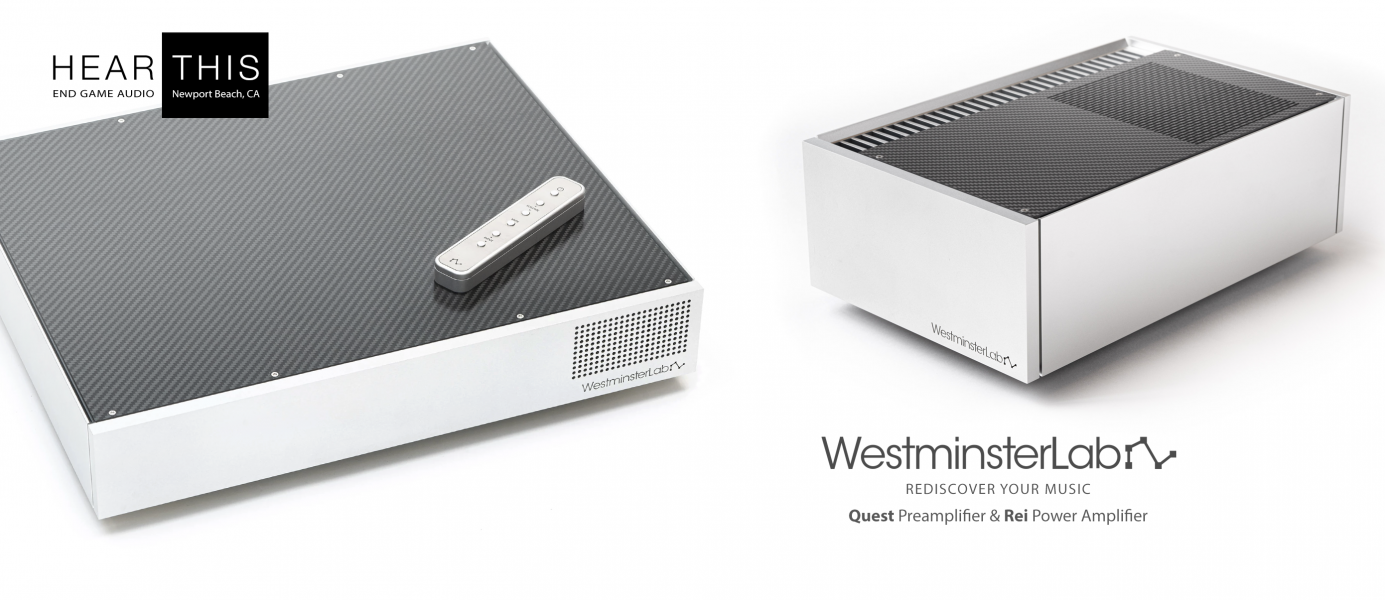
Attachments
Last edited:
No worries m2! Thank you for the question.
There are custom-sized amplifier stands designed for us by Falken Ohr Audio/Germany and Prana Distribution. This stand design is, of course, available for other amplifiers from Falken Ohr. Naturally, Westminster amplifiers may be purchased without the stands as well.
There are custom-sized amplifier stands designed for us by Falken Ohr Audio/Germany and Prana Distribution. This stand design is, of course, available for other amplifiers from Falken Ohr. Naturally, Westminster amplifiers may be purchased without the stands as well.
Preamplifiers in the Digital Age - are they needed?
View attachment 98534
Members of WBF have discussed the importance of a system preamplifier when owning a DAC with volume control onboard. MSB. Lampizator, CH Precision, and Lumin (the ladder using Leedh signal processing ) are excellent examples of the breed. While both uses are valid, like many choices, it is also a matter of taste which sounds better.
The Quest preamplifier is an active, fully balanced dual-mono design housed in an elegant, rigid aluminum chassis. The noise floor is very low due to the extensive use of Carbon fiber inside the chassis and the use of ten separate power supplies. In designing the Quest, the goal was to create a product that would act as a flexible control center and, at the same time, make a meaningful improvement in the sound quality of your system. The Quest is also available in a two-chassis dual mono configuration for ultimate performance.
In-home demos of the Quest are available for qualified individuals.
New item: The Quest Preamplifier Precision Phono Module "PPM"
View attachment 98533
Amplifying the tiny analog signals of a cartridge without distortion is a monumental task. So with this as our challenge, we set out to create a vinyl replay module for the Quest preamplifier compatible with the finest phono cartridges and delivering our hallmark sound signature - texture, transparency, detail, and dynamics. Two versions of the PPM are available with either balanced or single-ended inputs.
Here are the specifics.
Ultra-low current noise levels
Maintaining musical information in phono amplification requires a power source. Westminster's Precision Phono Module module uses specially designed power supplies inside the Quest as the primary power source. The signal then passes through a secondary filter resulting in very low measurable voltage deviation and current-related noise.
Precision RIAA Equalization
The RIAA Equalization circuit consists of only four passive components, a number far less than most phono stages on the market. However, not willing to forgo accuracy for our "less is more" circuit topology; we have also achieved within 0.5db of the RIAA reference. The result is accuracy and the ability to deliver information retrieved by the stylus as untouched as possible.
Flexible Impedance and Capacitance matching
The appropriate impedance settings are crucial to extracting the best possible performance from your cartridge. To meet these demands, we provide eighteen different impedance selections ranging from 60Ohm to 47kohm and five for input capacitance from 22p to 322pF. There are also three gain settings from 50db to 72db.
Three-stage precision amplification
Signals picked up from the cartridge are extremely small and require large multiples of amplification. Therefore, our PPM module uses an unconventional three-stage amplification process. Each stage is optimized to prevent overload and keep distortion as low as possible while acting in concert to apply accurate RIAA EQ equalization.
Bespoke Coupling Capacitors
AC signals produced by the cartridge are microscopic. Passive components used in most phono stages do not perform well in this environment. To solve this problem, the PPM uses custom capacitors to ensure distortion and coloration are at the lowest possible level, revealing newfound ease, flow, and previously obscured information.
True to the Original
Many phono preamplifiers use filters to reduce background noise and mitigate distortion. While this can result in a perceived sound quality improvement, we believe these filters rob music of critical information and add coloration. As a purist design, the PPM phono module reveals all the information found in the record groove so you can experience vinyl as it is!
The Quest preamplifier with or without phono stage is available for in-home auditions. Please get in touch with Gary Leeds via PM or email to inquire.
The Rei "Quadrablock" Amplifiers (4-chassis power solution)
View attachment 98522
The four-Rei Class A monoblocks are available where the Rei Quadrablocks leave off. From day one, the Rei used in Quadrablock configuration was designed for maximum performance and a simple upgrade path for existing monoblock amplifiers' owners. Vertical bi-amplification with a passive and active loudspeaker is also a perfect application for four amplifiers in regular unbridged mode.
Quadrablock power output
400 watts into 8 ohms
800 watts into 4 ohms
Not merely a strapped amplifier circuit, The Rei Quarablock was designed from day one to achieve maximum performance from our novel amplifier circuit topology, preserving and adding to the dynamics, detail, transparency, texture, and tonal density, and detail Reis' are becoming known.
View attachment 98535
Early in this thread I expressed interest in the Rei’s based on my proclivity for Class A operation as well as their paradoxically compact form factor. After some back and forth, Gary Leeds graciously sent a pair of Rei’s over which I listened to for a few weeks. On re-read of the thread, it seems to be full of effusive praise for the amps by interested parties/new owners countered by occasional callouts from skeptics. What is one to believe? I have no dog in this fight so here is my take:
Regardless of circuit topology or operational bias, these amps sound fantastic. Compared to my 60 wpc class A Luxman stereo amp, they are more open and transparent. An heightened sense of air, space and venue ambiance is readily apparent upon listening to favoured music such as “Besame Mucho” by guitarist Ulf Wakenius (or virtually anything else on the German ACT label). Bloom and decay are remarkable - check out Youn Sun Nah’s “Mercy Mercy Me” as a nice example if you ever land these amps for audition. They also edge out the Luxman on dynamics, detail, and speed. I had Joe Satriani’s “Not of This Earth” fired up to ear splitting levels while the WML’s remained unfazed.. Electronica fans?…the Rei’s are super “quick” and a wonderful match with my Tidal speakers when it comes to producing dizzying transients. Summary: colour me effused!
My Luxman amp puts out a darker, denser sound. It does fuller “tube-like” bass. This is not to say that the Rei’s have a thinnish sound with a short-lived, false sense of excitement. Nope - they are perfectly balanced top to bottom from a tonal point of view. Am I buying them? I might - but as I age, I have decided to put in as much time and effort into buying a major audio component as I do when buying a mattress. I suspect I would need/want the matching preamp at some point and the cost is well up there especially with the current strength of the USD vis a vis the Canuck buck. I have several good quality integrated amps on an audition queue and then there is also the un-liftable Luxman M-10X to consider …
Thanks to Gary for the opportunity to experience these amps…I’m seriously confident that a listen to these amps will turn any skeptic into a believer.
Regardless of circuit topology or operational bias, these amps sound fantastic. Compared to my 60 wpc class A Luxman stereo amp, they are more open and transparent. An heightened sense of air, space and venue ambiance is readily apparent upon listening to favoured music such as “Besame Mucho” by guitarist Ulf Wakenius (or virtually anything else on the German ACT label). Bloom and decay are remarkable - check out Youn Sun Nah’s “Mercy Mercy Me” as a nice example if you ever land these amps for audition. They also edge out the Luxman on dynamics, detail, and speed. I had Joe Satriani’s “Not of This Earth” fired up to ear splitting levels while the WML’s remained unfazed.. Electronica fans?…the Rei’s are super “quick” and a wonderful match with my Tidal speakers when it comes to producing dizzying transients. Summary: colour me effused!
My Luxman amp puts out a darker, denser sound. It does fuller “tube-like” bass. This is not to say that the Rei’s have a thinnish sound with a short-lived, false sense of excitement. Nope - they are perfectly balanced top to bottom from a tonal point of view. Am I buying them? I might - but as I age, I have decided to put in as much time and effort into buying a major audio component as I do when buying a mattress. I suspect I would need/want the matching preamp at some point and the cost is well up there especially with the current strength of the USD vis a vis the Canuck buck. I have several good quality integrated amps on an audition queue and then there is also the un-liftable Luxman M-10X to consider …
Thanks to Gary for the opportunity to experience these amps…I’m seriously confident that a listen to these amps will turn any skeptic into a believer.
Thanks, Ken. Angus and I appreciate the time and the positive comments very much!Early in this thread I expressed interest in the Rei’s based on my proclivity for Class A operation as well as their paradoxically compact form factor. After some back and forth, Gary Leeds graciously sent a pair of Rei’s over which I listened to for a few weeks. On re-read of the thread, it seems to be full of effusive praise for the amps by interested parties/new owners countered by occasional callouts from skeptics. What is one to believe? I have no dog in this fight so here is my take:
Regardless of circuit topology or operational bias, these amps sound fantastic. Compared to my 60 wpc class A Luxman stereo amp, they are more open and transparent. An heightened sense of air, space and venue ambiance is readily apparent upon listening to favoured music such as “Besame Mucho” by guitarist Ulf Wakenius (or virtually anything else on the German ACT label). Bloom and decay are remarkable - check out Youn Sun Nah’s “Mercy Mercy Me” as a nice example if you ever land these amps for audition. They also edge out the Luxman on dynamics, detail, and speed. I had Joe Satriani’s “Not of This Earth” fired up to ear splitting levels while the WML’s remained unfazed.. Electronica fans?…the Rei’s are super “quick” and a wonderful match with my Tidal speakers when it comes to producing dizzying transients. Summary: colour me effused!
My Luxman amp puts out a darker, denser sound. It does fuller “tube-like” bass. This is not to say that the Rei’s have a thinnish sound with a short-lived, false sense of excitement. Nope - they are perfectly balanced top to bottom from a tonal point of view. Am I buying them? I might - but as I age, I have decided to put in as much time and effort into buying a major audio component as I do when buying a mattress. I suspect I would need/want the matching preamp at some point and the cost is well up there especially with the current strength of the USD vis a vis the Canuck buck. I have several good quality integrated amps on an audition queue and then there is also the un-liftable Luxman M-10X to consider …
Thanks to Gary for the opportunity to experience these amps…I’m seriously confident that a listen to these amps will turn any skeptic into a believer.
I probably made a mistake when I posted the below post under its own threat Westminster Lab Equipment Makes My Bucket List System My Audio Bliss System . So I decided to post it here as well.
My Bucket List System has had an unplanned mega enhancement by the addition of a Westminster Lab Quest preamp and a pair of Westminster Lab REI monoblocs when all was supposed to already be in place. I also have the Westminster Lab phono card but due to some ongoing problems in my analog arm, I have not yet heard it.
It is hard for me to explain my thoughts and assessment of this last minute unexpected system change because I am still grappling with an equally, if not bigger change in my overall life due to my life threatening medical problems during the past year.
What initially seemed like a major problem to me because having to move into an assisted living facility for medical reasons meant that my projected audio future for my newly assembled Bucket List System was going to have to change massively, for both financial and almost guaranteed environmental reasons. Also, it meant my medical problems were progressing, which would be bad on all fronts.
As I was thinking about whether or not to move into a facility and being aggressively being pushed by one camp to move into a facility and get ready to die, or what made more sense to me and a number of my friends was trying to obtain my medical care at home and see how that worked out. I felt it would be the ultimate assessment of where I really was in life, especially since I live alone. Also, my home is nicer than a facility room and I also had my system and my boat, my other mind distracting toy there to help me cope with whatever is coming. Besides, those facilities are everywhere so I could easily move into one if it turned out that I needed that level of care.
I was surprised by the split of the people involved with my future because they were divided into two very different two camps, but it did force me to consider some things that I probably would not have thought about had I not gotten sick. I concluded that I wanted to enjoy the two biggest toys I have ever had, my system and my boat in my backyard, for as long as I could in hopes that at worst it would help me feel better as my medical condition progressed, and for sure would be a real bonus if I was doing okay. It was also cheaper and better having a house with many familiar aspects, than paying monthly facility fees (about $10k), and likely pissing the other residents off with my music.
I knew that this was the right choice for me in this most difficult and emotionally challenging decision of my life. It seriously stressed some of my relations with those in the pro-facility camp, but I knew I had to do what was right for me, and that was reach for a best case scenario and adjust as reality unfolded. Luckily, most are agreeing that it was a good call on my part with impressive results thus far.
So as anyone who has rationalized a purchase because they really wanted it, and not because it made sense, I decided to continue to pursue that last step on my path to audio bliss if I could afford it and thus increase my daily joy, regardless of what the future brings. As I have written already on WBF, I think the Westminster Lab equipment is perfect for my very weird circumstances. What I did not expect is how the Westminster Lab equipment would alter how I listen to music and even more important was the impact on me emotionally by listening to music when played with the Westminster Lab equipment at the core of my system.
I realized almost immediately with my first exposure to Westminster Lab products, that there was something very different to their product offerings, and that it excelled in areas that have been very important to me as I built systems over the years. I knew that doing anything possible to reduce distortion and lower the noise floor are design concepts I find fundamentally very important and desirable. I also have decided that the speed of the signal processing and responsiveness are also very important to me, meaning I would have to move away from product designs that have a more lush sound, as is frequently the case with many of the best tube products, as well as many solid state products.
Each of the Westminster Lab products have the same sonic signature of a remarkably black noise floor, that makes each component of the signal sound as if it is suspended in totally black space. I feel that this consistency is proof of Angus’s design capabilities, and helps me realize that almost nothing else is capable of matching the Westminster Lab equipment’s signal processing. The rise and decay times are so fast that you forget that you are listening to a simulation. The net result is that the believability of the sonics when using this equipment, reaches new levels that I have not experienced previously.
So let me apologize in advance for this typically atypical Russ post. I am a psychiatrist by trade with tons of clinical experience because I am driven to understand why people do what they do. I have concluded and validated via diverse clinical observations from my more than 40 years working in the human behavior aspects of many different scenarios that there are some basic commonalities to how humans function.
At the core of my thoughts in this area is that what one is actively thinking about becomes their reality at that point in time. The more they obsess about a thought, the greater the emotional impact and related energy drain. Since obsessional thinking is a common consequence of our hectic lifestyle, it is important to have diversions to help us reduce reflex obsessional thinking, and thus promote a calmer state of being. Said another way, listen to music through a good realistic system is very good for one’s overall being.
On some gut level when I first realized my love of music and emerging hobby of being an audio fan was driven by my personal need to get out of my head, especially as I aged and my obsessing progressively drove me to become a workaholic servicing my 426 patients who came seeking my psychiatric and addiction medicine services at least once a month.
So insidiously, my core needs from my system du jour were to help me get out of my head ASAP. In fact, what I dreamed of as my ultimate audio goal was to have the best system I could create and afford in my living room so I could happily sit and listen to music as long as I wanted and as loud as I wanted to help me get out of my head. I envisioned this as audio nirvana for a single guy. I projected that having this scenario would be a true pleasure on a sonic front, and a definite trophy that showed me that I achieved one of my lifelong goals and had a ball along the way. I speculated that this equipment and living scenario would help improve my emotional state, especially if my medical problems continued to progress. Of course, I believed and hoped that it would also help me feel better overall. The reality is that it has become one of the most important tools for my overall healing on a medical front. I would be in a much less good place if I did not have this system with the Westminster Lab equipment at its core.
Like most of you on this site, I use music and my lifelong pursuit of the truest and most believable sound system I can create as a way to clear my mind while enjoying my favorite hobby. I truly believed or at least rationalized that the addition of the Westminster Lab products to the core of my system would convert it to my sought after wonder system that would probably produce audio bliss whenever I desired, AKA My Bucket List System.
Well, it turned out that the combination of the amazingly low noise floor and the speed of the signal rises and decays and Angus’s Westminster Lab circuit designs produced so much believability that a major byproduct was ejecting less than necessary thoughts from my mind when sitting in the sonic beam because the sonic display was so much more captivating, leaving me with a much better mind state and thus a much improved mood.
There is one potential downside - it is so captivating that it is very easy to sit and listen for hours on a daily basis. Previously, this is something I only projected, but rarely had time to do, rather than my current retired approach of using my system for both listening to music, and producing endless personal “you are there” experiences, because of the believability of the sonic presentation and more than sufficient power to demand your attention within seconds of sitting in the sonic beam. By the way, I actively use the system to help shift my thinking when I am having a bad day, making me a much happier person to be around and even more important to have more joy at my core.
My Bucket List System has had an unplanned mega enhancement by the addition of a Westminster Lab Quest preamp and a pair of Westminster Lab REI monoblocs when all was supposed to already be in place. I also have the Westminster Lab phono card but due to some ongoing problems in my analog arm, I have not yet heard it.
It is hard for me to explain my thoughts and assessment of this last minute unexpected system change because I am still grappling with an equally, if not bigger change in my overall life due to my life threatening medical problems during the past year.
What initially seemed like a major problem to me because having to move into an assisted living facility for medical reasons meant that my projected audio future for my newly assembled Bucket List System was going to have to change massively, for both financial and almost guaranteed environmental reasons. Also, it meant my medical problems were progressing, which would be bad on all fronts.
As I was thinking about whether or not to move into a facility and being aggressively being pushed by one camp to move into a facility and get ready to die, or what made more sense to me and a number of my friends was trying to obtain my medical care at home and see how that worked out. I felt it would be the ultimate assessment of where I really was in life, especially since I live alone. Also, my home is nicer than a facility room and I also had my system and my boat, my other mind distracting toy there to help me cope with whatever is coming. Besides, those facilities are everywhere so I could easily move into one if it turned out that I needed that level of care.
I was surprised by the split of the people involved with my future because they were divided into two very different two camps, but it did force me to consider some things that I probably would not have thought about had I not gotten sick. I concluded that I wanted to enjoy the two biggest toys I have ever had, my system and my boat in my backyard, for as long as I could in hopes that at worst it would help me feel better as my medical condition progressed, and for sure would be a real bonus if I was doing okay. It was also cheaper and better having a house with many familiar aspects, than paying monthly facility fees (about $10k), and likely pissing the other residents off with my music.
I knew that this was the right choice for me in this most difficult and emotionally challenging decision of my life. It seriously stressed some of my relations with those in the pro-facility camp, but I knew I had to do what was right for me, and that was reach for a best case scenario and adjust as reality unfolded. Luckily, most are agreeing that it was a good call on my part with impressive results thus far.
So as anyone who has rationalized a purchase because they really wanted it, and not because it made sense, I decided to continue to pursue that last step on my path to audio bliss if I could afford it and thus increase my daily joy, regardless of what the future brings. As I have written already on WBF, I think the Westminster Lab equipment is perfect for my very weird circumstances. What I did not expect is how the Westminster Lab equipment would alter how I listen to music and even more important was the impact on me emotionally by listening to music when played with the Westminster Lab equipment at the core of my system.
I realized almost immediately with my first exposure to Westminster Lab products, that there was something very different to their product offerings, and that it excelled in areas that have been very important to me as I built systems over the years. I knew that doing anything possible to reduce distortion and lower the noise floor are design concepts I find fundamentally very important and desirable. I also have decided that the speed of the signal processing and responsiveness are also very important to me, meaning I would have to move away from product designs that have a more lush sound, as is frequently the case with many of the best tube products, as well as many solid state products.
Each of the Westminster Lab products have the same sonic signature of a remarkably black noise floor, that makes each component of the signal sound as if it is suspended in totally black space. I feel that this consistency is proof of Angus’s design capabilities, and helps me realize that almost nothing else is capable of matching the Westminster Lab equipment’s signal processing. The rise and decay times are so fast that you forget that you are listening to a simulation. The net result is that the believability of the sonics when using this equipment, reaches new levels that I have not experienced previously.
So let me apologize in advance for this typically atypical Russ post. I am a psychiatrist by trade with tons of clinical experience because I am driven to understand why people do what they do. I have concluded and validated via diverse clinical observations from my more than 40 years working in the human behavior aspects of many different scenarios that there are some basic commonalities to how humans function.
At the core of my thoughts in this area is that what one is actively thinking about becomes their reality at that point in time. The more they obsess about a thought, the greater the emotional impact and related energy drain. Since obsessional thinking is a common consequence of our hectic lifestyle, it is important to have diversions to help us reduce reflex obsessional thinking, and thus promote a calmer state of being. Said another way, listen to music through a good realistic system is very good for one’s overall being.
On some gut level when I first realized my love of music and emerging hobby of being an audio fan was driven by my personal need to get out of my head, especially as I aged and my obsessing progressively drove me to become a workaholic servicing my 426 patients who came seeking my psychiatric and addiction medicine services at least once a month.
So insidiously, my core needs from my system du jour were to help me get out of my head ASAP. In fact, what I dreamed of as my ultimate audio goal was to have the best system I could create and afford in my living room so I could happily sit and listen to music as long as I wanted and as loud as I wanted to help me get out of my head. I envisioned this as audio nirvana for a single guy. I projected that having this scenario would be a true pleasure on a sonic front, and a definite trophy that showed me that I achieved one of my lifelong goals and had a ball along the way. I speculated that this equipment and living scenario would help improve my emotional state, especially if my medical problems continued to progress. Of course, I believed and hoped that it would also help me feel better overall. The reality is that it has become one of the most important tools for my overall healing on a medical front. I would be in a much less good place if I did not have this system with the Westminster Lab equipment at its core.
Like most of you on this site, I use music and my lifelong pursuit of the truest and most believable sound system I can create as a way to clear my mind while enjoying my favorite hobby. I truly believed or at least rationalized that the addition of the Westminster Lab products to the core of my system would convert it to my sought after wonder system that would probably produce audio bliss whenever I desired, AKA My Bucket List System.
Well, it turned out that the combination of the amazingly low noise floor and the speed of the signal rises and decays and Angus’s Westminster Lab circuit designs produced so much believability that a major byproduct was ejecting less than necessary thoughts from my mind when sitting in the sonic beam because the sonic display was so much more captivating, leaving me with a much better mind state and thus a much improved mood.
There is one potential downside - it is so captivating that it is very easy to sit and listen for hours on a daily basis. Previously, this is something I only projected, but rarely had time to do, rather than my current retired approach of using my system for both listening to music, and producing endless personal “you are there” experiences, because of the believability of the sonic presentation and more than sufficient power to demand your attention within seconds of sitting in the sonic beam. By the way, I actively use the system to help shift my thinking when I am having a bad day, making me a much happier person to be around and even more important to have more joy at my core.
Hi Russ, I'm sorry to hear of your health problems. I do understand where you are coming from with respect to the WML products - the Rei amps at least. One of my best friends is a psychiatrist - he is supposed to keep me calm on the golf course but but this is a perennial failure.
cheers,
Ken
cheers,
Ken
Fred,I've spent the last week getting to know this equipment. I've had the amps and preamp on every different types of speakers we have to see how it handles Scintilla like loads on the one hand, and 107 db sensitive horns on the other. Still haven't put in their cables. I hope to do that this evening.
The real take away for me is that this is a different kind of amplification...I know it's class A, but it has its own gestalt which required a re-wiring of the way I hear and audition. Often times my favorite gear asks this of me. You have to go into this realm understanding that this is a new ballgame. The images are dense...players pop out of thin air. Granted, I've only been playing around with these pieces for about a week, but they're something special. The fact that you can very simply daisy chain the amps to go to 200@8, 400@4 and 800@2 (and I think even beyond that if one wanted to daisy chain 3 amps per side) makes them even more compelling for all kinds of applications. For instance, one system I favor is comprised of large OB's in a large room. 3 amps per side would be the ticket. They were designed for this expansion without any deterioration to the signal.
There's also an industrial art to these pieces. Carbon Fiber used to isolate within the amps and preamp...every trick known and a few unknown to limit vibration and shorten signal paths. There was something about custom extra thick PCBs as well. All to say, very thoughtful engineering and construction. My Better Half thought they looked great compared to some of the massive amps I've had in house. These guys are small but without compromise so far as I can hear. A must audition...even if they're not to your liking, you want this sound in the aural rolodex of your brain...I have a feeling this tech is going to be around for a good long while. I'd be shocked if other companies didn't borrow from them.
Beautifully stated and 100% in agreement with your assessment. I have had mine for about 1 1/2 months and am just throughly in love with this equipment and how it has impacted my life. Although what I had previously, was absolutely amazing tube gear. I have become a huge fan of ultra low noise floors with screamingly fast rise and decay times., which at least for me helps promote the believability of the presentation.
I must say I also like the compact size of the units, and yet regularly rely on their prodigious power to create "you are there experiences."
Steve,Me too
im fascinated that pure class A can come in such a little box but I’ve also heard about some even smaller amps Angus has built which are also pure Class A.
I understand your thinking on this front, but have also shifted my assessment system to lean heavily how a new piece of gear enhances my listening enjoyment as I perceive it. As I have written extensively on WBF, the addition of this equipment to my system helped push my Bucket List System to the audio nirvana I have dreamed about since I was 10. It is a good thing I am retired because I spend many hours almost every day listening to whatever strikes my fancy. Another bonus is the sonic image truly calms me down dramatically, helping me heal my current medical problems!!!
Greetings, all!
I wanted to extend a formal invitation to those of you going to Capital AudioFest to come hear our presentation of the Westminster REIs amplifier and Quest preamp.
Our presentation will be in room 524 and we will be running a surprise new statement speaker from GT Audio alongside the LampizatOr Horizon DAC in what will be a very special space.
Gary and I look forward to meeting some fellow WBFers there!
Fred A.
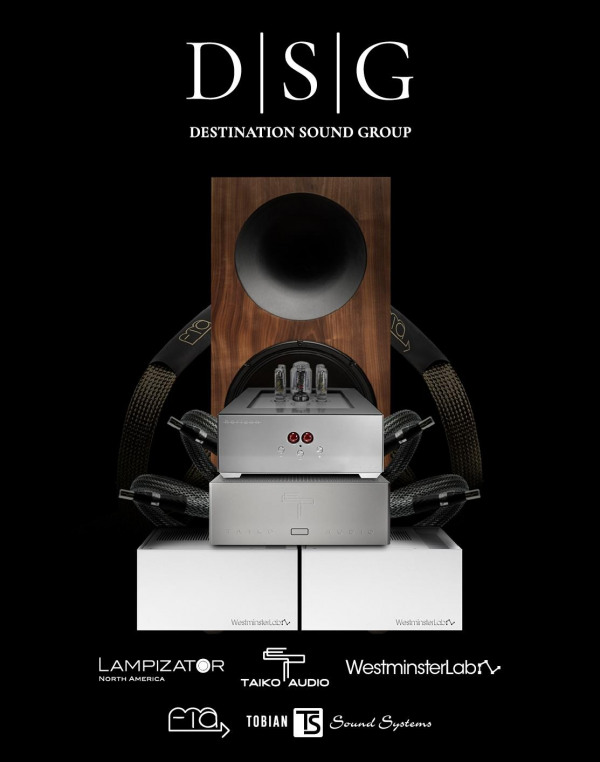
I wanted to extend a formal invitation to those of you going to Capital AudioFest to come hear our presentation of the Westminster REIs amplifier and Quest preamp.
Our presentation will be in room 524 and we will be running a surprise new statement speaker from GT Audio alongside the LampizatOr Horizon DAC in what will be a very special space.
Gary and I look forward to meeting some fellow WBFers there!
Fred A.

Did I read correctly in the post from which this is taken that it has variable capacitance at the input?The appropriate impedance settings are crucial to extracting the best possible performance from your cartridge.
Usually with LOMC cartridges you might want different resistive 'loading' values, not capacitance. Capacitance interacts with a cartridge by creating an electrical resonance with the inductance of the cartridge, being in parallel with it. There is already capacitance of the tonearm cable. Adding more decreases the resonant frequency. With a LOMC cartridge this resonance might be anywhere from 100KHz to 5MHz and if driven to excitation manifests as RFI at the input of the phono section.
If its a high output cartridge the inductance is much higher, placing the resonance at the upper end of the audio band or just outside it. If not loaded correctly this can lead to brightness.
In either case adding capacitance in parallel with the input decreases the resonant frequency and isn't desirable: with a high output cartridge the brightness peak is moved to a lower frequency; with a LOMC cartridge the RFI is moved lower, making it harder to filter. Can I assume the text from which I took this quote came from the marketing department rather than the engineering department? You might want to look into this.
I may have stated something technically as the marketing man in this case. Angus will respond in due course and put to bed any technical inaccuracy contained therein.
Surprising, Ralph, for the tone and timing of your post, especially immediately following the positive energy of Fred’s announcement that Westminster Lab will be making their first US show appearance at the Capital Audio Fest on 11/11. Knowing you by reputation, I am sure that was unintentional, so no harm, no foul.
Thank you for your post, Fred. We cannot wait to be with you, LampzatOr, and the boys from GT Audio Works at CAF. It's going to be a blast!
Surprising, Ralph, for the tone and timing of your post, especially immediately following the positive energy of Fred’s announcement that Westminster Lab will be making their first US show appearance at the Capital Audio Fest on 11/11. Knowing you by reputation, I am sure that was unintentional, so no harm, no foul.
Thank you for your post, Fred. We cannot wait to be with you, LampzatOr, and the boys from GT Audio Works at CAF. It's going to be a blast!
I hadn't read the thread in a while. You are correct. So I would take a look at your text there- I'm not the only one aware of the cartridge loading issues I mentioned!I may have stated something technically as the marketing man in this case. Angus will respond in due course and put to bed any technical inaccuracy contained therein.
Surprising, Ralph, for the tone and timing of your post, especially immediately following the positive energy of Fred’s announcement that Westminster Lab will be making their first US show appearance at the Capital Audio Fest on 11/11. Knowing you by reputation, I am sure that was unintentional, so no harm, no foul.
Thank you, Ralph.I hadn't read the thread in a while. You are correct. So I would take a look at your text there- I'm not the only one aware of the cartridge loading issues I mentioned!
Similar threads
- Replies
- 22
- Views
- 2K
- Replies
- 17
- Views
- 2K
- Replies
- 142
- Views
- 35K
- Replies
- 6
- Views
- 805
- Replies
- 7
- Views
- 4K
| Steve Williams Site Founder | Site Owner | Administrator | Ron Resnick Site Owner | Administrator | Julian (The Fixer) Website Build | Marketing Managersing |







